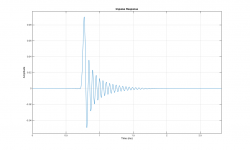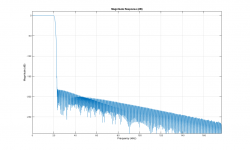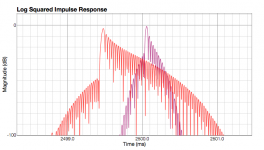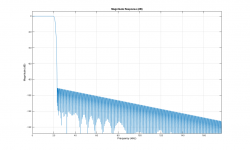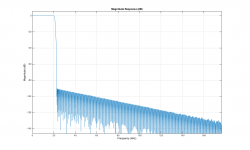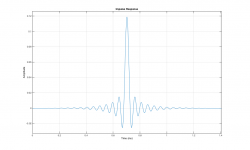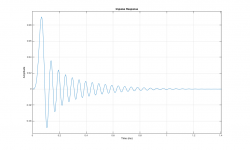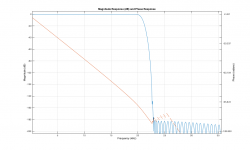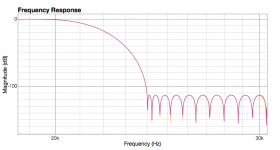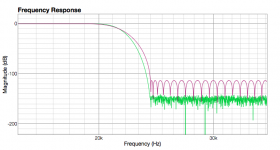The laws of physics evolve so fast, it is hard to stay fashionable 😉
Jocking aside, I will have a look, thank you.
That was a joke about being passé of course...
I'm ignoring the impulse and step plots for filters at the moment because I think it's been obscuring more important aspects of the filter config. I think we are getting better results with deep attenuation and steep rolloff - both which are counter to the short filter, little ringing school of thought.
The Pflaumer patent has some interesting information, and since reading I've noticed that Peter Craven who developed Meridian's apodizing filters used log squared impulse response plots in his AES papers...
Last edited:
bambadoo & spzzzzkt, thank you.
If you are looking for something that should measure well, the EQ_n001 and EQ_n010 would be worth a try.
The idea of these filters, as with the brick wall filters, is to:
- eliminate aliasing/imaging as far as possible, by attenuating heavily at nyquist.
- minimise activity in the R2R ladder during conversion by attempting to push activity in the stop band lower than the 28th bit or approx 168dB
Excuse the music used in this clip... turn down if you are offended by early noughties doof-doof.
What this illustrates is the stop band behaviour of the stock filter (110dB) vs a more recent 168dB attenuation filter. This was done by processing a short clip with the filter coefficients using SoX - not perfect but close enough for jazz. Real time spectrum analysis done in RX. The audio is not well sync'd but is really just to give an idea of what the spectrum analysis represents.
https://www.youtube.com/watch?v=8eM6TeZmUBc
Consider that the quantisation level for 28 bits is roughly 168dB, so anything above -168dB is going to be reproduced at a low level but ultrasonic frequency by the DAC. It is definitely well below the threshold of audibility but the DAC will still be shifting the values for this "junk" through the shift registers and into the R2R ladder continuously.
Last edited:
the EQ_n001 and EQ_n010 would be worth a try.
That should be EQ_n011 of course.
The sound of playback software
Just a thought but if you are using PC software for playback, I'd suggest having a listen to a couple of different options, even if you are set on your current player.
I've been using Audirvana + for all the testing, and know if I go back to Pure Music 2.0 the sound becomes darker and more smooth sounding. In fact the reason I purchased A+ was to add some sparkle to a dark sounding DAC. It's a bit more robust for flipping between tracks so I've stayed with it.
Anyway the thought crossed my mind that perhaps Pure Music wasn't an outlier in terms of being dark, so did some listening tests.
My conclusion is either iTunes, Amarra and Pure Music are all dark sounding, or A+ is comparatively bright. I'm opting for the latter.
It may well be that most DAC's are voiced a little bit soft/warm and benefit from the "sharpened" focus that A+ brings but it just sounds comparatively thin/bright vs others I've compared it with on the DAM.
Anyway that is to my ear, and in my system, and ymmv as per usual.
But if you are doing computer playback, it's worth taking a listen at what the player software does to the overall sound quality.
Just a thought but if you are using PC software for playback, I'd suggest having a listen to a couple of different options, even if you are set on your current player.
I've been using Audirvana + for all the testing, and know if I go back to Pure Music 2.0 the sound becomes darker and more smooth sounding. In fact the reason I purchased A+ was to add some sparkle to a dark sounding DAC. It's a bit more robust for flipping between tracks so I've stayed with it.
Anyway the thought crossed my mind that perhaps Pure Music wasn't an outlier in terms of being dark, so did some listening tests.
My conclusion is either iTunes, Amarra and Pure Music are all dark sounding, or A+ is comparatively bright. I'm opting for the latter.
It may well be that most DAC's are voiced a little bit soft/warm and benefit from the "sharpened" focus that A+ brings but it just sounds comparatively thin/bright vs others I've compared it with on the DAM.
Anyway that is to my ear, and in my system, and ymmv as per usual.
But if you are doing computer playback, it's worth taking a listen at what the player software does to the overall sound quality.
Amarra plays music without software resampling. To play CD at 44.1/16, and 96/24 music Amarra is the best.
And perfect for test your hardware resampling DAM filters. And selecting the adequate brewed filter doesn't add any brittleness or hardness.
Pure Music and Audirvana can software resampling at x2 multiples frequency, CD music at 352 with DAM1021 and is the best mode to listening all type of frequency sample music in the DAM1021 at 352 and 384..
iTunes made always software resample at system default frequency audio settings. If the default system configuration is 44.1 khz. iTunes is perfect for 44,1/16 CD music but bad for the rest of frequency music 48/24 88/24 96/24. Or you need to continuously change the frequency of systema for each type of music.
Perhaps is my amp valves.
On the other hand I need to try HQPlayer OSX.
And perfect for test your hardware resampling DAM filters. And selecting the adequate brewed filter doesn't add any brittleness or hardness.
Pure Music and Audirvana can software resampling at x2 multiples frequency, CD music at 352 with DAM1021 and is the best mode to listening all type of frequency sample music in the DAM1021 at 352 and 384..
iTunes made always software resample at system default frequency audio settings. If the default system configuration is 44.1 khz. iTunes is perfect for 44,1/16 CD music but bad for the rest of frequency music 48/24 88/24 96/24. Or you need to continuously change the frequency of systema for each type of music.
Perhaps is my amp valves.
On the other hand I need to try HQPlayer OSX.
Amarra plays music without software resampling.
What I'm talking about is a distinct tonal difference between the players, and this difference has been noted in a number of comparative reviews of OS X players.
see for example...
OS X audio Player Review
Perhaps things have changed since the above review identified Amarra as the darkest player in 2012. I'd definitely rank Pure Music 2 as the darkest sounding player of the bunch. Audrivana is consistently identified as the "most detailed".
My contention is that A+ is noticeably brighter than iTunes, Amarra, and Pure Music when all are configured for 44.1/16 bit perfect playback. And it's this characteristic that doesn't play nicely with the DAM imo.
Last edited:
Eye of Newt, toe of frog...
well maybe not that bad, but close.
It finally clicked that I could apply the idea used in rePhase of blending linear and minimum phase filter to create a intermediate phase filter in MATLAB.
The method is to make two filters that fit within the constraints of 1016 taps. So 2 x 508 tap filters, or a filter order of 507.
Make the specification the same for both, and set the stop band attenuation to half what is required in the final filter.
Create linear and minimum phase versions of this filter
Convolve the two filters together.
It's a bit to do painful but provides a very usable result with no windowing.
Attached is an example...
well maybe not that bad, but close.
It finally clicked that I could apply the idea used in rePhase of blending linear and minimum phase filter to create a intermediate phase filter in MATLAB.
The method is to make two filters that fit within the constraints of 1016 taps. So 2 x 508 tap filters, or a filter order of 507.
Make the specification the same for both, and set the stop band attenuation to half what is required in the final filter.
Create linear and minimum phase versions of this filter
Convolve the two filters together.
It's a bit to do painful but provides a very usable result with no windowing.

Attached is an example...
Attachments
Hardcore. What's a filter like this look like in the frequency domain and impulse response? You're good at making pretty graphs so thought I'd ask 🙂
Hardcore. What's a filter like this look like in the frequency domain and impulse response? You're good at making pretty graphs so thought I'd ask 🙂
Indeed...
combined filter impulse:
combined frequency response:
Both of the "parent" filters have roll-off in the stop band. I could probably cut back on the attenuation slightly and get steeper roll-off but it's not too bad as is. There is a small step in the transition band response at -150dB. Izotope has a similar step so I'm not going to fret about it too much..
LSIR n017 vs SoX IP35
Base Linear Phase filter response
Base Linear Phase impulse
Base Minimum Phase filter response
Base Minimum Phase impulse
Attachments
Last edited:
Thanks. Forgot to request phase shift too lol guess that's the most important with incorporating minimum phase filtering...
Importantly how's it sound to your ears?
Edit: oh and when you say "unwindowed" does that mean just rectangular window applied?
Importantly how's it sound to your ears?
Edit: oh and when you say "unwindowed" does that mean just rectangular window applied?
Last edited:
Been listening to Sox HiAtt recently, enjoying the music rather than trying to decide which filter I like best. Interesting reading thoughts and input from everyone along the way, and thanks Paul once again for creating so many options to try and enjoy, and talking about your work! Then you go and ask about players & software...
I’ve been using the PC thus far trying JRiver given this is what the pros appear to use at the hifi shows. Thought this time I’d give the Mac a try (Macbook Pro, Early 2011) so we’re all talking about and working from the same platform. Output is via USB to the Amanero.
I like the open sounding Amarra Sonic Studio, which I find compares well with Audivanna. The sound is perhaps a tad bright on both, but not what I’d call aggressive. While the former is arguably a little more even-handed, the latter perhaps a tiny fraction more revealing, I bet however, anyone would be hard-pressed to tell them apart. Vox was okay too albeit I focussed my efforts on the As given they look to be some of the more respected players, haven’t tried iTunes or any of the others. I set Audivanna to exclusive and mode 1, should that make any difference? Perhaps more interesting was using Audivanna to upsame 44.1k to 352.8k thus bypassing the filters in the dac. Maybe this gives a better picture of what the filters in the dac are up to? To my mind the music felt a little more relaxed, and lost some of the brightness somehow. It felt ‘more natural’ - but how do I describe what I heard? I was happy with all the options I tried although would likely go for up-sampled if asked to choose. I wonder sometimes what is fact and what perception/fiction when evaluating different options? I do think however, the fact the up-sampled compares so well with 44k speaks well for the filters you’ve created Paul. Perhaps we have too many options from which to choose?! Find one you like and stick with it. Now to try the ‘unwindowed’ filter... 🙂
I’ve been using the PC thus far trying JRiver given this is what the pros appear to use at the hifi shows. Thought this time I’d give the Mac a try (Macbook Pro, Early 2011) so we’re all talking about and working from the same platform. Output is via USB to the Amanero.
I like the open sounding Amarra Sonic Studio, which I find compares well with Audivanna. The sound is perhaps a tad bright on both, but not what I’d call aggressive. While the former is arguably a little more even-handed, the latter perhaps a tiny fraction more revealing, I bet however, anyone would be hard-pressed to tell them apart. Vox was okay too albeit I focussed my efforts on the As given they look to be some of the more respected players, haven’t tried iTunes or any of the others. I set Audivanna to exclusive and mode 1, should that make any difference? Perhaps more interesting was using Audivanna to upsame 44.1k to 352.8k thus bypassing the filters in the dac. Maybe this gives a better picture of what the filters in the dac are up to? To my mind the music felt a little more relaxed, and lost some of the brightness somehow. It felt ‘more natural’ - but how do I describe what I heard? I was happy with all the options I tried although would likely go for up-sampled if asked to choose. I wonder sometimes what is fact and what perception/fiction when evaluating different options? I do think however, the fact the up-sampled compares so well with 44k speaks well for the filters you’ve created Paul. Perhaps we have too many options from which to choose?! Find one you like and stick with it. Now to try the ‘unwindowed’ filter... 🙂
Trying EQMP N017, immediate impression having replaced Sox HiAtt... Sharper, more focussed, faster and arguably a more dynamic. Okay, only 2 minutes of listening, but for sure my new favourite. Again Paul, thank you!! Think you could well be on to something here, well worth following up. Have tried Matlab to design and create a filter but thus far without any success. Will have to fire up the turntable and compare the new filter.
Thanks. Forgot to request phase shift too lol guess that's the most important with incorporating minimum phase filtering...
Importantly how's it sound to your ears?
Edit: oh and when you say "unwindowed" does that mean just rectangular window applied?
No windowing at all. These are not designed using a windowed sinc method. They are made with Remez/Parks McCelland algorithm which designs optimised filters using an approximation method.
Parks?McClellan filter design algorithm - Wikipedia, the free encyclopedia
I'm using the fdesign.lowpass function from MATLAB, with the equiripple design method.
Lowpass filter specification - MATLAB fdesign.lowpass - MathWorks Australia
Phase/Response...
I've not had a chance for proper listen - partner was home sick today so had to be a bit considerate when I got home, but it does sound pretty good. It's on a par with the other equiripple filters, maybe a little better. I should get a chance to do some comparisons tomorrow afternoon...
What did jump out was that it sounded amazing with a mp3 of Depth Charge's "Dead By Dawn". Just happened to throw it on because I remembered it had a sample taken from Evil Dead II, which was on SBS2 last night. 😉
https://www.youtube.com/watch?v=L_zLuGjpWxA
The distinct layering and placement of the elements in the mix was something I'd never really noticed, but it's a while since I listened to it.
An interesting test track in Kraftwerk's "Metropolis" - there is a "ploink" that slowly moves in circles above the synth pads. It rises in frequency and apparent height through the first minute or so of the track. I noticed one difference between players was that the vertical separation between the pads and circling synth "ploink" was noticeably different between players. I'll add it to my audition track list...
https://www.youtube.com/watch?v=b6bhuJ0pTcg
Attachments
Thanks spzzzzkt. Font of knowledge as always.
Considering its an intermediate filter I was expecting a flat 0 phase shift for a region of the phase graph. Is this possible? I was reading in the Mod86 amp thread and someone there posted that humans can't really detect phase shifts > ~3 KHz. Is it possible to create filter with zero phase shift from DC to certain frequency and have min. phase from then on?
I would love to try and run some sims myself but don't have access to Matlab for a few weeks :/
Considering its an intermediate filter I was expecting a flat 0 phase shift for a region of the phase graph. Is this possible? I was reading in the Mod86 amp thread and someone there posted that humans can't really detect phase shifts > ~3 KHz. Is it possible to create filter with zero phase shift from DC to certain frequency and have min. phase from then on?
I would love to try and run some sims myself but don't have access to Matlab for a few weeks :/
Thanks spzzzzkt. Font of knowledge as always.
Considering its an intermediate filter I was expecting a flat 0 phase shift for a region of the phase graph. Is this possible? I was reading in the Mod86 amp thread and someone there posted that humans can't really detect phase shifts > ~3 KHz. Is it possible to create filter with zero phase shift from DC to certain frequency and have min. phase from then on?
I would love to try and run some sims myself but don't have access to Matlab for a few weeks :/
Nvm, looking at your graph again I think you have actually achieved this and I'm talking out my a$$. Your phase response is linear to ~22 kHz! Duh!
Man I ask a lot of foolish questions in hindsight ><
Last edited:
The 'kkkkatz gone mad...
You know your in trouble when you spend time trying to clone the default Soekris filter 😱
I think I did a pretty good job... Tap length came out the same and the passband and rolloff overlay perfectly. Stop band ripple is slightly different frequency. Oh well. The best thing is the clone sounds identical to the stock 44.1 filter. 😀
The orange trace is the original filter, the burgundy is the "klone" filter.

So not much difference...
The reason I've done this is so I can test the theory that much of the harshness in the stock filter comes from the 113dB stop band attenuation. To do this I wanted to get a base filter which was as close as possible to the stock 44.1/48.1kHz.
From that starting point, with identical pass band and stop band frequencies to the original I could modify the passband ripple and stop band attenuation specs to something more alone the lines of the recent filters.
This has blown out the filter taps significantly, and the roll-off is now steeper, and more ringing etc...

The green trace is the HiAtt Klone.
The clone of the stock 44.1 filter is SK441_orig_klone.skr.
The high attenuation, reduced pass band ripple, version is SK441klone.skr
So this is mainly an "out of interest" filter to see how much difference the added attenuation makes. In theory if the harshness is related to imaging around nyquist the two filters should sound equally harsh.
One of my test tracks looses a harsh "spitty" edge to the sibilance on the vocals with the HiAtt Klone. I guess -0.4dB at 20kHz might make some difference...
The other thing that is the faint haze around instruments in the Stock filter is gone on the hi attenuation version, which improves the sense of space in the recording. Who says -113dB is below the threshold of audibility?
You know your in trouble when you spend time trying to clone the default Soekris filter 😱
I think I did a pretty good job... Tap length came out the same and the passband and rolloff overlay perfectly. Stop band ripple is slightly different frequency. Oh well. The best thing is the clone sounds identical to the stock 44.1 filter. 😀
The orange trace is the original filter, the burgundy is the "klone" filter.
So not much difference...
The reason I've done this is so I can test the theory that much of the harshness in the stock filter comes from the 113dB stop band attenuation. To do this I wanted to get a base filter which was as close as possible to the stock 44.1/48.1kHz.
From that starting point, with identical pass band and stop band frequencies to the original I could modify the passband ripple and stop band attenuation specs to something more alone the lines of the recent filters.
This has blown out the filter taps significantly, and the roll-off is now steeper, and more ringing etc...
The green trace is the HiAtt Klone.
The clone of the stock 44.1 filter is SK441_orig_klone.skr.
The high attenuation, reduced pass band ripple, version is SK441klone.skr
So this is mainly an "out of interest" filter to see how much difference the added attenuation makes. In theory if the harshness is related to imaging around nyquist the two filters should sound equally harsh.
One of my test tracks looses a harsh "spitty" edge to the sibilance on the vocals with the HiAtt Klone. I guess -0.4dB at 20kHz might make some difference...
The other thing that is the faint haze around instruments in the Stock filter is gone on the hi attenuation version, which improves the sense of space in the recording. Who says -113dB is below the threshold of audibility?
Attachments
Yes, harshness was gone when you started producing high attenuation filters ☺
Yes, but that was done in combination with moving to close to nyquist full attenuation.
The issue with doing two things simultaneously is that its difficult to be clear about what influence each aspect is having. Just trying to clarify exactly what the variables are...
There are clear implications for what you do with the filters if for example your friend Mr. Pflaumer is correct in his claims that it is transition band distortion and imaging that creates mid-range harshness. It would be nice to actually test that theory methodically, rather than just accepting it as fact without verification. The tests of the BADA seem to suggest he's not especially strict about nyquist these days.
Lol thought you were going to take it easier... 😛
Side effect of insomnia... it won't last, i would say 2-3 hours at most.
- Home
- Source & Line
- Digital Line Level
- Filter brewing for the Soekris R2R
